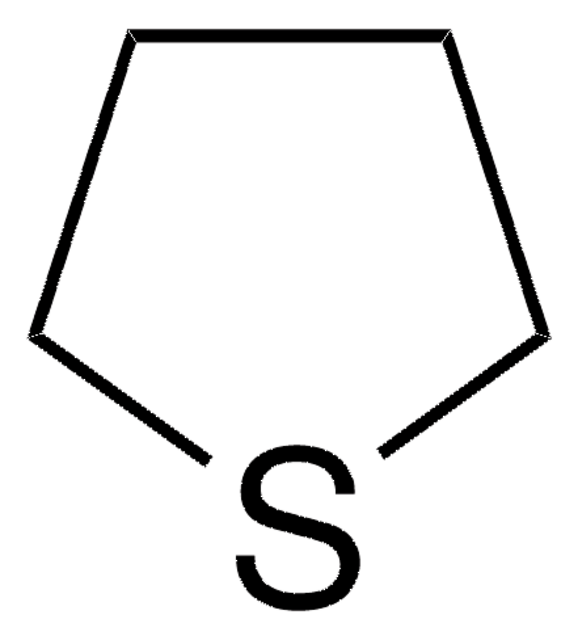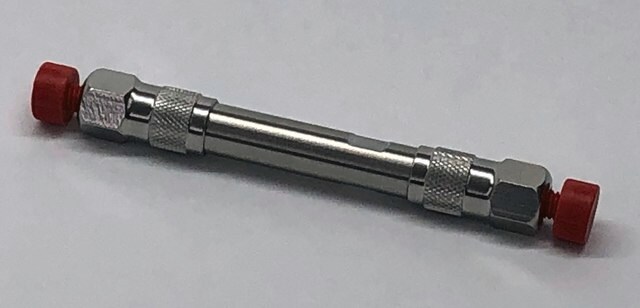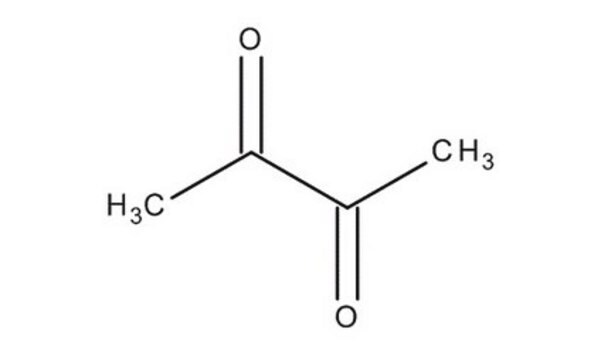8.20833
Dimethyl sulfide
for synthesis
Synonyme(s) :
Dimethyl sulfide, Methyl sulfide
About This Item
Produits recommandés
Pression de vapeur
530 hPa ( 25 °C)
Niveau de qualité
Essai
≥99.0% (GC)
Forme
liquid
Température d'inflammation spontanée
205 °C
Puissance
535 mg/kg LD50, oral (Rat)
>5000 mg/kg LD50, skin (Rabbit)
Limite d'explosivité
2.2-19.7 % (v/v)
pb
37 °C/1013 hPa
Pf
-98 °C
Température de transition
flash point <-30 °C
Solubilité
7.28 g/L
Densité
0.85 g/cm3 at 20 °C
Température de stockage
2-8°C
InChI
1S/C2H6S/c1-3-2/h1-2H3
Clé InChI
QMMFVYPAHWMCMS-UHFFFAOYSA-N
Catégories apparentées
Application
- Application of Synthetic Flavors in Zebrafish Rearing: The study details the effects of using synthetic flavors, including dimethyl sulfide, in the aquaculture of zebrafish, highlighting benefits in fish development and welfare. This application suggests potential for broader aquaculture practices (Conti et al., 2023).
- Impact of Sulfur Fertilizers on Potato Tuber Flavor: Research explored the combined application of phosphorus and sulfur fertilizers on the flavor of potato tubers, noting that sulfur compounds like dimethyl sulfide can influence agricultural product quality (Li et al., 2023).
- Two-Dimensional Platelets Assembly: A study demonstrated the use of small molecules including dimethyl sulfide for the living self-assembly of metastable and stable two-dimensional platelets, offering insights into novel materials engineering methods (Liao et al., 2023).
- Enhancement of Volatile Flavor Compounds: Investigation on the effect of instant pressure drop treatment on the volatile flavor compounds in whole highland barley flour. The study emphasizes the role of dimethyl sulfide in enhancing food flavors through advanced processing techniques (Chen et al., 2023).
- Role in Marine Biogeochemical Cycles: This research highlighted the contribution of fungi to the increased production of dimethylsulfoniopropionate (DMSP), a precursor to dimethyl sulfide, in kelp ecosystems, underscoring its importance in marine biogeochemical cycles (Perkins et al., 2023).
Remarque sur l'analyse
Density (d 20 °C/ 4 °C): 0.847 - 0.849
Identity (IR): passes test
Mention d'avertissement
Danger
Mentions de danger
Conseils de prudence
Classification des risques
Flam. Liq. 2
Code de la classe de stockage
3 - Flammable liquids
Classe de danger pour l'eau (WGK)
WGK 1
Point d'éclair (°F)
-32.8 °F - closed cup
Point d'éclair (°C)
-36 °C - closed cup
Certificats d'analyse (COA)
Recherchez un Certificats d'analyse (COA) en saisissant le numéro de lot du produit. Les numéros de lot figurent sur l'étiquette du produit après les mots "Lot" ou "Batch".
Déjà en possession de ce produit ?
Retrouvez la documentation relative aux produits que vous avez récemment achetés dans la Bibliothèque de documents.
Notre équipe de scientifiques dispose d'une expérience dans tous les secteurs de la recherche, notamment en sciences de la vie, science des matériaux, synthèse chimique, chromatographie, analyse et dans de nombreux autres domaines..
Contacter notre Service technique





